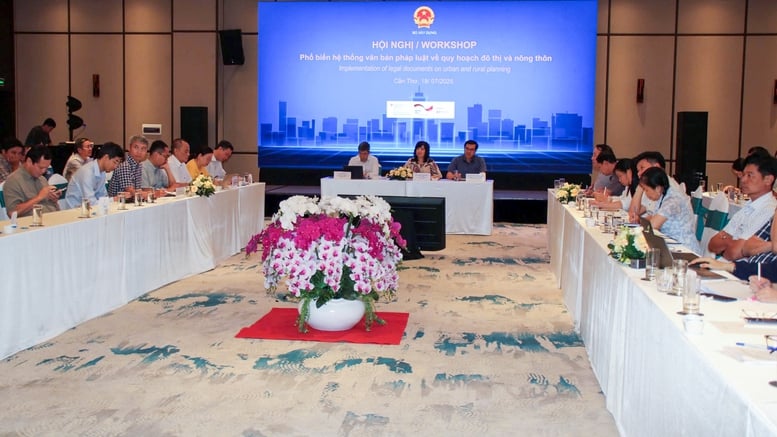
Delegates attending the Conference in Can Tho City on July 18 - Photo: /LS
Many new and detailed regulations
At the conference, the Department of Planning and Architecture ( Ministry of Construction ) focused on introducing to delegates some important contents of the Law on Urban and Rural Planning; Circular 16 of the Minister of Construction detailing a number of articles of the Law on Urban and Rural Planning; Circular 17 of the Minister of Construction promulgating norms, methods of establishing and managing costs for urban and rural planning activities...
According to the Department of Planning and Architecture, the new Law clearly stipulates the urban and rural planning system in terms of types and levels; simplifies planning cases to the maximum extent, and does not require separate zoning planning levels for medium and small urban areas, contributing to reducing time and costs.
In order to simplify the procedures in planning, appraisal and approval, the Law does not require consulting the community on the general planning tasks of cities, towns, districts and functional areas (except for new urban areas, towns and communes), but only consults relevant State management agencies.
In addition, clearly stipulate the minimum and maximum time for collecting opinions on planning projects for residential communities; do not require approval from People's Councils at all levels for general planning of cities, towns, economic zones, and national tourist areas before being approved by competent authorities.
At the same time, strengthen decentralization and delegation of authority in planning, appraisal, approval and adjustment. Specifically, the provincial People's Committee is authorized to organize the preparation of general planning for centrally-run cities, economic zones, and national tourist areas under the approval authority of the Prime Minister; organize the preparation and approval of new urban general planning with planning scope related to the administrative boundaries of 2 or more commune-level administrative units; commune general planning; underground space planning, and specialized technical infrastructure.
For commune level, urban and rural planning within the management area is established and approved, except for cases established by functional area management agencies/organizations or investors.
On the other hand, the Law supplements and strictly regulates the conditions and requirements for local planning adjustments but does not change the nature, function, boundary scope, main planning solutions and does not overload technical infrastructure, social infrastructure, and complies with standards.
The new regulation also provides very detailed regulations on electronic records of urban and rural planning. This is one of the highlights and major changes in the construction and management of planning databases.
Clearly define two-level responsibilities
Within the framework of the program, agencies and localities will exchange, share and clarify new points in legal documents. The focus will be on the content of the division of authority of local authorities at two levels in the establishment and adjustment of urban and rural planning; the continued implementation of zoning plans that have a general plan approved before the Law on Urban and Rural Planning takes effect.
According to Ms. Tang Thi Dep, Deputy Director of the Department of Construction of Vinh Long province, the implementation of two-level local government has led to many changes in rural and urban planning.
"Planning is the premise, the legal basis for implementing socio-economic development so that we can implement socio-economic development, carry out investment projects. But currently, merging the current planning of wards and communes is already available, but it is very difficult to implement. In the new regulations, it is binding that communal planning cannot be established. So how should we establish it?", Ms. Dep asked.
The representative of the Department of Construction of An Giang province commented on whether the locality needs to re-establish previous plans and submit them to competent authorities for approval or not?
"The locality with the planning for Phu Quoc City is now quite special. Previously, the authority to adjust was approved by the Provincial People's Committee. The new regulation requires the authorities at the commune and ward levels of the special zone. But here, the Phu Quoc Economic Management Board also participates in organizing the planning. So according to the new law, will the local authorities or the Economic Zone Management Board approve this planning?", said a representative of the An Giang Department of Construction.
Regarding the issues raised by the delegates, Mr. Vu Anh Tu, Deputy Director of the Department of Planning and Architecture, said: "The new law clearly stipulates that approved plans will continue to be implemented. In case of needing adjustments to suit the socio-economic development situation, the provincial People's Committee can do this."
"The planning of Phu Quoc special economic zone is carried out by the People's Committee and the Economic Management Board. In our opinion, this authority is assigned by the Provincial People's Committee, and is also permitted by law," the Deputy Head of the Department of Planning and Architecture emphasized.
Demarcation of authority between two levels of local government
Speaking at the conference, Director of the Department of Planning and Architecture Tran Thu Hang said that to specify the provisions of the Law on Urban and Rural Planning, the Prime Minister issued a decision and assigned the Ministry of Construction to preside over the drafting of documents guiding its implementation.
Implementing the Prime Minister's direction, the Ministry of Construction has closely coordinated with ministries, branches, localities, professional organizations and experts nationwide to develop, collect opinions and complete guidance documents.
The above regulations have been carefully studied by the Ministry of Construction to ensure that the regulations are highly feasible and consistent with the relevant legal system such as land, investment, construction, housing, real estate business, etc.
From there, create a clear and transparent legal corridor for local authorities at all levels to properly perform their assigned responsibilities, promote initiative in management, organization and planning.
According to Ms. Hang, in the guiding documents and detailed regulations on urban and rural planning laws this time, the important highlight is the clear division of authority when organizing local governments at two levels and the decentralization and delegation of authority in the field of urban and rural planning.
The division of authority between two levels of local government is specifically designed, consistent with the provisions on decentralization and delegation in the entire relevant legal system, and at the same time clearly defines the authority between levels of local government.
This not only helps reduce the burden on central agencies, but also creates conditions for localities to be more proactive and flexible in managing urban and rural planning.
LS
Source: https://baochinhphu.vn/tang-cuong-phan-cap-phan-quyen-trong-lap-tham-dinh-phe-duyet-va-dieu-chinh-quy-hoach-102250718212723441.htm





![[Video] More than 100 universities announce tuition fees for the 2025–2026 academic year](https://vphoto.vietnam.vn/thumb/1200x675/vietnam/resource/IMAGE/2025/7/18/7eacdc721552429494cf919b3a65b42e)
























































































![[Infographic] In 2025, 47 products will achieve national OCOP](https://vphoto.vietnam.vn/thumb/402x226/vietnam/resource/IMAGE/2025/7/16/5d672398b0744db3ab920e05db8e5b7d)





Comment (0)